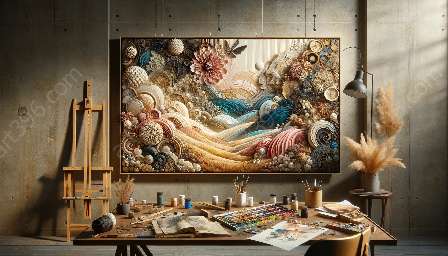Contemporary mixed media art has become a potent platform for artists to address issues of identity and diversity in profoundly compelling ways. With a fusion of diverse artistic elements and creative techniques, mixed media art allows artists to convey complex narratives, challenge stereotypes, and celebrate the richness of human experiences.
Understanding Mixed Media Art
Mixed media art refers to artwork that utilizes a combination of different artistic mediums, such as painting, collage, assemblage, and digital elements. It allows artists to break free from traditional artistic constraints and explore new ways of creating meaning and expression. This versatile form of art provides a unique opportunity for artists to delve into the intricate nuances of identity and diversity.
Embracing Cultural Identity
One of the primary ways through which mixed media art addresses issues of identity and diversity is by providing a platform for artists to explore their cultural heritage and individual identity. Artists are able to blend elements from their own cultural backgrounds and experiences to create pieces that reflect the complex multiplicity of identity. Through the use of diverse materials, textures, and imagery, mixed media art captures the rich tapestry of human existence, and celebrates the beauty of cultural diversity.
Challenging Stereotypes
Contemporary mixed media art serves as a powerful tool for challenging and deconstructing societal stereotypes. By incorporating unexpected combinations of materials, symbols, and imagery, artists can disrupt conventional perceptions and narratives surrounding identity and diversity. This subversion of stereotypes prompts viewers to engage with artwork on a deeper level, fostering critical reflection and dialogue about the multifaceted nature of identity.
Voicing Marginalized Experiences
Mixed media art also provides a platform for individuals from marginalized communities to share their stories and experiences. Artists use a diverse range of mediums to amplify the voices of those who are often underrepresented in mainstream narratives. By infusing their artwork with personal narratives, mixed media artists bring attention to the challenges and resilience of diverse communities, fostering empathy and understanding among viewers.
Celebrating Intersectionality
Another compelling aspect of how mixed media art addresses identity and diversity is the celebration of intersectionality. Through the integration of various artistic elements, artists are able to visually articulate the intersections of multiple identities, such as race, gender, sexuality, and class. This multidimensional approach underscores the complexity of individual experiences and fosters a deeper appreciation for the diversity within communities.
Fostering Inclusivity
Contemporary mixed media art actively promotes inclusivity and representation by offering a space for artists to express the full spectrum of human identities. By embracing a wide range of materials and techniques, mixed media art embodies the belief that diversity is an essential part of artistic expression. This inclusivity encourages a broader and more inclusive dialogue about identity and diversity, engaging audiences from different backgrounds.
Conclusion
Contemporary mixed media art serves as a dynamic means of addressing issues of identity and diversity, offering a visually compelling and thought-provoking platform for artists to convey diverse narratives, challenge stereotypes, and celebrate the multifaceted nature of human experiences. Through a fusion of artistic mediums, mixed media art captures the essence of cultural identity, challenges conventional narratives, amplifies marginalized voices, celebrates intersectionality, and fosters inclusivity, making it a vital form of artistic expression in the contemporary world.

